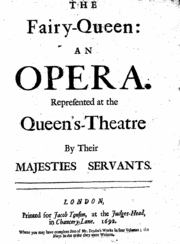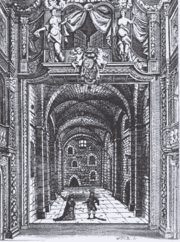The Fairy-Queen
2007 Schools Wikipedia Selection. Related subjects: Poetry & Opera
The Fairy-Queen (Z.629) is a masque or semi-opera by Henry Purcell. It was first performed on May 2, 1692 at Queen's Theatre, Dorset Garden in London. It was composed for the United Company of the Theatre Royal. The libretto comes from an anonymous adaptation of William Shakespeare's comic play A Midsummer Night's Dream. A possible author of the libretto is Thomas Betterton, with whom Purcell worked on Dioclesian, and choreography for the various dances was provided by Josias Priest, with whom Purcell also worked on Dioclesian, King Arthur, and who was also associated with Dido and Aeneas. Purcell did not set any of Shakespeare's text to music; instead he created short masques in between acts of the play, similar to the Italian intermezzo. Some of Shakespeare's text was modernized so that its meaning would be clear to seventeenth century audiences. The masques are related to the play metaphorically, rather than literally; for instance, the "Masque of Hymen" precedes an affirmation of the wedding vows.
Context and analysis
Following the huge success of his opera Dido and Aeneas, Purcell composed The Fairy-Queen in 1692. Shakespeare's play was almost 100 years old by that time and therefore the librettist refashioned the original text considerably in order that it might suit a modern palate. The fact that this was necessary is illustrated by the following quotation (written as part of a eulogy to the composer just after his death), which shows the low regard in which Shakespeare's plays were held, and how essential a musical adaptation was for a successful production.
- How was the Scene forlorn, and how despised
- When Tymon, without Musick, moralize'd?
- Shakespears sublime in vain entic'd the Throng,
- Without the charm of Purcels' Syren Song.
- When Tymon, without Musick, moralize'd?
The English tradition of semi-opera, to which The Fairy-Queen belongs, demanded that music be only introduced in scenes concerning love or the supernatural; therefore Purcell has the Fairies introduce all the masques and scenes provided with music. Originally Act 1 contained no music, but the work's enormous success meant that when it was revived in 1693 Purcell added the scene of the Drunken Poet and two further songs later on in the work; "Ye gentle spirits of the air" and "The Plaint". As said above, each masque is subtly related to the action in the play during that particular act in a metaphorical way; therefore we have Night and Sleep in Act 2 (apt as that act of the play consists of Oberon's plans to use the power of the "love-in-idleness" flower to confuse various loves, and it is therefore appropriate for the allegorical figures of Secrecy, Mystery et al to usher in a night of bewitchment), Titania's bewitchment in Act 3 (self-explanatory), Reconciliation in Act 4 (also fitting as just previously peace has been restored to the characters as Oberon's plans succeed), and the "Chinese" Paradisical rapture in Act 5. The "Act tunes" were composed to replace the lowering of the curtain, and the "First and Second Musick" were written to be played while the audience were taking their seats. After Act 1, each act commences with a short symphony (3 - 5 minutes).
Performance history
Following Purcell's premature death, popular consideration of his music fell into decline fairly quickly; by 1730 his harmonies were already thought to be old-fashioned, and The Fairy-Queen and other works like it fell into obscurity. However, changing tastes were not the only reason for the abandonment of the work; the voices employed had also become difficult to find. The list of singers below shows the frequent employment of the male alto, or countertenor, in the semi-opera, a voice which, after Purcell, essentially vanished from the stage, probably due to the rise of Italian opera and the attendant castrati, and after that Romatic opera and the attendant predominance of the tenor. The male alto survived purely in the ecclesiastical tradition of all-male church choirs.
However, Purcell's music (and with it The Fairy-Queen) was resuscitated by the rise of two approximately coincidental movements: a growing interest in early music and the baroque period, and the rise of the countertenor, lead by pioneers such as Alfred Deller and Russell Oberlin. The former lead to performances of long-neglected composers such as Purcell, Dowland, Blow and even Handel, while the latter complemented it by providing a way of making such performances as authentic as possible as regards the original performances and the composer's intentions (less true for Handel, where countertenors appear as castrati replacements). This has led to The Fairy-Queen assuming increased popularity, and several recordings have been made, often using period instruments. The format of the work presents problems to modern directors, who must decide whether to present Purcell's music as part of the original play, which uncut is a lengthy business (having paid for their ticket, Jacobean audiences of this period quite often expected five to six hours of entertainment in return, a fact that at least partially explains the existence of the semi-opera format), and difficult for the aesthetics of modern audiences, or to present the series of masques on their own, running the risk of incoherence. A video of an English National Opera production of the work was released in 1995.
The music
Written as he approached the end of his brief career, The Fairy-Queen contains some of Purcell's finest theatre music, as musicologists have agreed for generations. In particular, Constant Lambert was a great admirer; from it he arranged a suite and in collaboration with Edward Dent arranged the work to form the then new Covent Garden opera company's first postwar production. It shows to excellent effect Purcell's complete mastery of the pungent English style of Baroque counterpoint, as well as displaying his absorption of Italian influences. Several arias such as "The Plaint", "Thrice happy lovers" and "Hark, now the echoing air" have entered the discographic repertory of many singers outside their original context.
The orchestra for The Fairy-Queen consists of two flutes, two oboes, two trumpets, kettledrums, strings and harpsichord continuo.
Singers
- Drunken Poet- baritone
- First Fairy- soprano
- Second Fairy-soprano
- Night-soprano
- Mystery-soprano
- Secrecy- countertenor
- Sleep-baritone
- Corydon-baritone
- Mopsa- soprano/countertenor
- Nymph-soprano
- 3 Attendants to Oberon-1 soprano, 2 countertenors
- Phoebus- tenor
- Spring-soprano
- Summer-countertenor
- Autumn-tenor
- Winter-baritone
- Juno-soprano
- Chinese Man-countertenor
- Chinese Woman ( Daphne)-soprano
- Hymen-baritone
- An SATB chorus of Fairies and Attendants. Typically, the chorus is used at the end of airs to provide a recapitulation of the main theme of the air, as well as at moments of particular dramatic grandeur, such as at the entry of Phoebus during Act 4.
It should perhaps here be noted that the role of Mopsa was originally performed by soprano; however, a later revision by Purcell stated that it was to be performed by "Mr. Pate in woman's habit", presumably to have a grotesque effect and highlight the refrain "No, no, no, no, no; no kissing at all" in the dialogue between Corydon and Mopsa.
It should also perhaps here be noted that it is not entirely clear what the word "countertenor" means in this context. The record is ambivalent as to whether Purcell (himself a countertenor) used a tenor with a particularly high range (though lighter at the top) and tessitura (known sometimes as a haute-contre; the descendants of the contratenors alti of medieval polyphony), or a falsettist. It seems that throughout his career he used both (see also the Laura DeMarco link in the "References" section below). However, purely for reasons of dramatic verisimilitude, it is more likely than not that the travesty role of Mopsa was taken by a falsettist, and the presence of a duet for two male altos ("Let the fifes and the clarions") makes it seem more probable that for this work falsettists were employed.
Synopsis
- Acts 1 and 2: The first scene set to music occurs after Titania has left Oberon, following an argument over the ownership of a little Indian boy. Two of her fairies sing of the delights of the countryside ("Come, come, come let us leave the town"). A drunken, stuttering poet enters, singing "Fill up the bowl then". The stuttering has led many to believe the scene is based on the habits of Thomas d'Urfey: however, it may also be poking fun at Elkanah Settle, who also stuttered and was long thought to be the librettist, due to an error in his 1910 biography. The fairies mock the drunken poet and drive him away. Act 1 ends. Act 2 begins after Oberon has ordered to Puck to anoint the eyes of Demetrius with the love-juice. Titania and her fairies merrily revel ("Come all ye songsters of the sky"), and Night ("See, even Night"), Mystery ("I am come to lock all fast"), Secrecy ("One charming night") and Sleep ("Hush, no more, be silent all") lull them asleep and leave them to pleasant dreams.
- Acts 3, 4, and 5: Act 3 commences after Titania has fallen in love with Bottom (now equipped with his ass's head), much to Oberon's gratification. A Nymph sings of the pleasures and torments of love ("If love's a sweet passion") and after several dances, Titania and Bottom are entertained by the foolish, loving banter of two haymakers, Corydon and Mopsa. Act 4 (which begins after Titania has been freed from her enchantment) commences with a brief divertissement to celebrate Oberon's birthday ("Now the Night", and the abovementioned "Let the fifes and the clarions"), but for the most part it is a masque of the god Phoebus ("When the cruel winter") and the Four Seasons (Spring; "Thus, the ever grateful spring", Summer; "Here's the Summer", Autumn; "See my many coloured fields", and Winter; "Now Winter comes slowly"). Act 5 (after Theseus has been told of the lovers's adventures in the wood) commences with the goddess Juno singing an epithalamium, "Thrice happy lovers", followed by a woman who sings the well–known "The Plaint" ("O let me weep"). A Chinese man and woman enter singing several songs describing Paradise ("Thus, the gloomy world", "Thus happy and free" and "Yes, Xansi"). Two further women summon Hymen, the god of marriage, who is persuaded to bless the union of all the faithful lovers in the final masque.
Recordings
- Alfred Deller, The Deller Consort, Stour Music Chorus (2 CDs) — ( 1972) — Harmonia Mundi
- John Eliot Gardiner, The English Baroque Soloists The Monteverdi Choir, (2 CDs) — 1982 — Archiv Produktion 419 221-2
- William Christie, Les Arts Florissants (2 CDs) — 1989 — Harmonia Mundi HMC 90 1308/0
- Roger Norrington, The London Classical Players, The Schütz Choir of London (2 CDs) — 1994 — EMI Classics 7243 5 55234 2 6
- Ton Koopman, Amsterdam Baroque Orchestra and Chorus, (2 CDs) — 1994 — Erato 98507
- Nikolaus Harnoncourt, Concentus Musicus Wien, Arnold Schoenberg Chor (2 CDs) — 1995 — Teldec Classics 4509-97684-2

